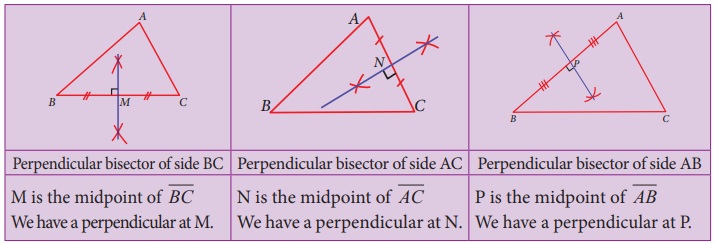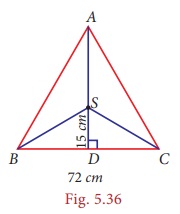Geometry | Chapter 5 | 8th Maths - Perpendicular Bisectors of a Triangle | 8th Maths : Chapter 5 : Geometry
Chapter: 8th Maths : Chapter 5 : Geometry
Perpendicular Bisectors of a Triangle
Perpendicular
Bisectors of a Triangle
Let us first
recall the following ideas.

Consider
a triangle ABC. It has three sides. For each side you can have a perpendicular bisector
as follows:

Surprisingly,
all the three perpendicular bisectors of the sides of a triangle are concurrent
at a point!
Activity
One can visualize the point of concurrence of the perpendicular bisectors,
through simple paper folding. Try and see that,
The perpendicular bisectors
of the sides of any triangle are concurrent.

As done in the earlier activity on Centroid, you can repeat the experiment
for various types of triangle, acute, obtuse, right, isosceles and equilateral.
Do you find anything special with the equilateral triangle in this case?
1. Circumcentre
The point
of concurrence of the three perpendicular bisectors of a triangle is called as its
Circumcentre, denoted by the letter S.

Why should
it be called so? Because one can draw a circle exactly passing through the three
vertices of the triangle, with centre at the point of concurrence of the perpendicular
bisectors of sides. Thus, the circumcentre is equidistant from the vertices
of the triangle.
Activity
Check if the following are true by paper-folding:
• The circumcentre of an acute angled triangle lies in the interior
of the triangle.
• The circumcentre of an obtuse angled triangle lies in the exterior
of the triangle.
• The circumcentre of a right triangle lies at the midpoint of its
hypotenuse.
Example 5.19
In ∆ABC,
S is the circumcentre, BC = 72 cm and
DS = 15 cm. Find the radius of its circumcircle.

Solution:
As S is the circumcentre of ∆ABC, it is equidistant from A,B and C. So AS=BS=CS=radius of its circumcircle. As AD is the perpendicular bisector of BC, BD = 1/2 ×BC = 1/2 ×72 = 36 cm
In right
angled triangle BDS, by Pythagoras theorem,
BS2
= BD2 +SD2 = 362 + 152 = 1521
= 392
⇒ BS
= 39cm.
∴The
radius of the circumcircle of ΔABC is 39 cm.
Related Topics